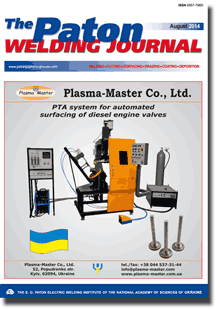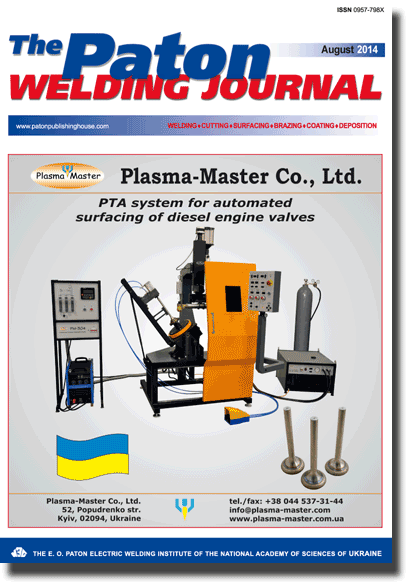| 2014 №08 (08) |
DOI of Article 10.15407/tpwj2014.08.09 |
2014 №08 (01) |

The Paton Welding Journal, 2014, #8, 54-57 pages
WEAR-RESISTANT ARC SURFACING OVER THE LAYER OF ALLOYING CHARGE
V.V. PEREMITKO
Dneprodzerzhinsk State Technical University. 2 Dneprostroevskaya Str., 51918, Dneprodzerzhinsk, Ukraine. E-mail: welding@dstu.dp.ua
Abstract
Given are the results of study of structure, hardness and relative wear resistance of surface layers of parts, restored by submerged arc surfacing with addition of powdered materials and superposition of external magnetic axial field. Using powders of silicon carbide SiC and aerosil SiO2 the paste-like mixture on the base of GF-021 primer was prepared and deposited by beads along the surfacing direction. During experiments the composition of mixture, number of layers being deposited, eccentricity in arrangement of layers relative to electrode wire axis, as well as induction of external magnetic field were varied. Coming from the obtained results, the highest values of hardness of the deposited metal were observed at B = 20-50 mT. Optimum pitch in deposition of layers is 4-6 mm. Hardness is growing with increase of number of layers being deposited. Regression equations of mentioned relationships are presented. Due to external magnetic field it became possible to decrease the heat effect on added powdered materials without melting of their particles. Analysis of microstructures proves the effect of magnetic field on crystallization. The uniform distribution of particles of powdered material was occurred, grain number reached 10-12 over 6-8 initial one. Wear tests revealed the least losses in mass of specimens, deposited with addition of SiO2 particles. In this case the allowable plastic deformation and maximum increase in hardness of surface layers are occurred. 8Ref., 4 Tables, 4 Figures.
Keywords: submerged arc surfacing, external magnetic field, powders SiC and SiO2, mixtures on the base of primer, analysis of microstructure, hardness, regression relationships, wear resistance
Received: 17.03.14
Published: 28.08.14
References
1. Ryabtsev, I.A., Senchenkov, I.K. (2013) Theory and practice of surfacing operations. Kiev: Ekotekhnologiya.
2. Chigarev, V.V., Malinov, V.L. (2000) Selection of sparcely-alloyed surfacing materials for different impact-abrasive conditions. The Paton Welding J., 5, 55-57.
3. (2000) Repair and increase in wear resistance and service life of machine parts. Ed. by V.S. Popov. Zaporozhie: Motor Sich.
4. Lifshits, L.S., Grinberg, N.A., Kurkumelli, E.G. (1969) Principles of deposited metal alloying. Moscow: Mashinostroenie.
5. Frumin, I.I. (1961) Automatic electric arc surfacing. Kharkov: Metallurgizdat.
6. Razmyshlyaev, A.D., Mironova, M.V. (2009) Magnetic control of formation of beads and welds in arc surfacing and welding. Mariupol: Priazov. STU.
7. Ryzhov, R.M., Kuznetsov, V.D. (2010) Magnetic control of welded joint quality. Kiev: Ekotekhnologiya.
8. Peremitko, V.V. (2013) Development and investigation of repair surfacing technology of undercarriage rollers of caterpillar machines. In: Proc. of 15th Int. Sci.-Pract. Conf. on Technology of Strengthening, Coating Deposition and Repair. Theory and Practice, Pt1, 168-172. St.-Petersburg: SPU.
Suggested Citation
V.V. PEREMITKO (2014) WEAR-RESISTANT ARC SURFACING OVER THE LAYER OF ALLOYING CHARGE. The Paton Welding J., 08, 54-57.The cost of subscription/purchase order journals or individual articles
| Journal/Currency | Annual Set | 1 issue printed |
1 issue |
one article |
| TPWJ/USD | 384 $ | 32 $ | 26 $ | 13 $ |
| TPWJ/EUR | 348 € | 29 € | 24 € | 12 € |
| TPWJ/UAH | 7200 UAH | 600 UAH | 600 UAH | 280 UAH |
| AS/UAH | 1800 UAH | 300 UAH | 300 UAH | 150 UAH |
| AS/USD | 192 $ | 32 $ | 26 $ | 13 $ |
| AS/EUR | 180 € | 30 € | 25 € | 12 € |
| SEM/UAH | 1200 UAH | 300 UAH | 300 UAH | 150 UAH |
| SEM/USD | 128 $ | 32 $ | 26 $ | 13 $ |
| SEM/EUR | 120 € | 30 € | 25 € | 12 € |
| TDNK/UAH | 1200 UAH | 300 UAH | 300 UAH | 150 UAH |
| TDNK/USD | 128 $ | 32 $ | 26 $ | 13 $ |
| TDNK/EUR | 120 € | 30 € | 25 € | 15 € |
AS = «Automatic Welding» - 6 issues per year;
TPWJ = «PATON WELDING JOURNAL» - 12 issues per year;
SEM = «Electrometallurgy Today» - 4 issues per year;
TDNK = «Technical Diagnostics and Non-Destructive Testing» - 4 issues per year.


